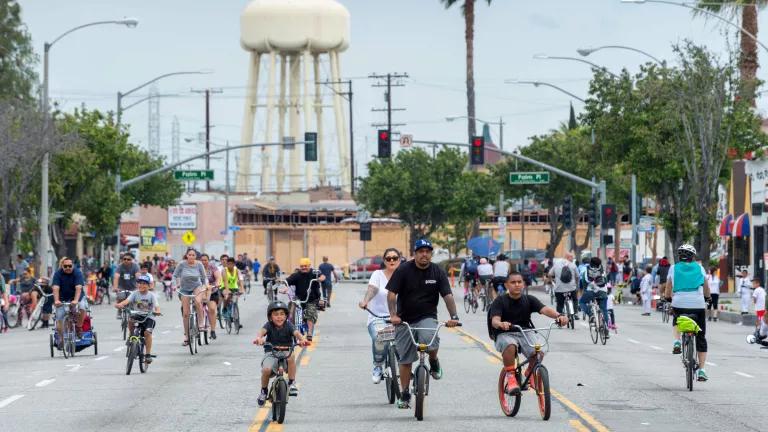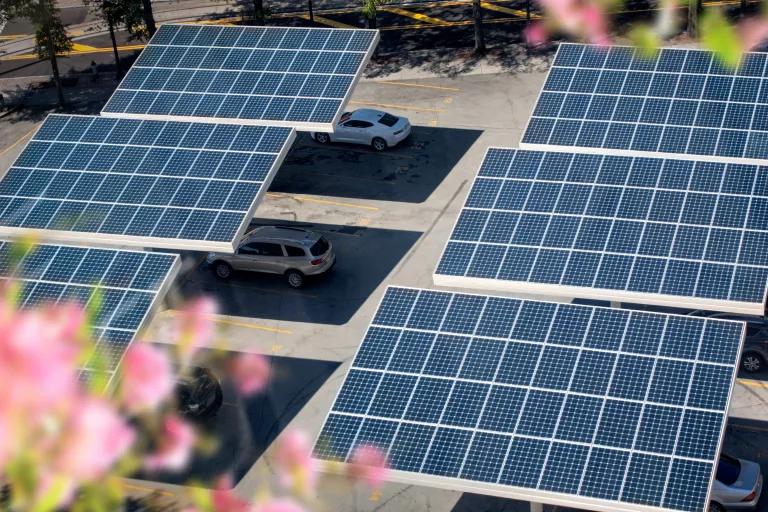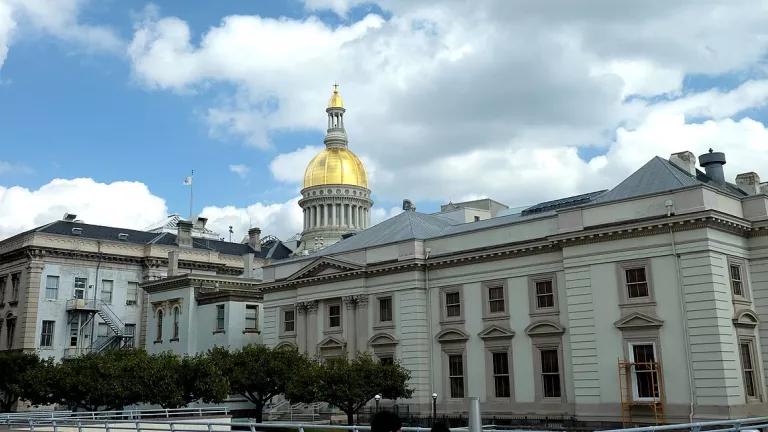How Frontline Communities Can Take Advantage of the Inflation Reduction Act to Advance Local Priorities
A breakdown of some of the major opportunities available to community-based organizations and some actionable steps to get more involved in this space.

Families cycling down a street in the Florence-Firestone neighborhood of Los Angeles, California, during a CicLAvia event on May 16, 2016
Steve Hymon/Metro, CC BY-NC-SA 4.0
You’ve probably heard of the Inflation Reduction Act (IRA), the largest climate investment in U.S. history. Projected to cut carbon emissions by an estimated 40 percent by 2030, this new climate law provides more than $369 billion for clean energy projects, environmental justice initiatives, and decarbonizing the transportation and energy sectors.
The IRA, along with the Bipartisan Infrastructure Law (BIL), is one of the largest sources of funding for programs under the Justice40 Initiative, which directs 40 percent of the overall benefits to Disadvantaged Communities (DACs). DACs are defined by geography, using indicators from the Climate and Economic Justice Screening Tool (CJEST), or by a common condition. If you are a community-based organization (CBO) serving frontline communities, you might be wondering how you can actually take advantage of the IRA and its various programs.
First, there are two important ways CBOs and community groups can take advantage of the benefits within IRA:
- Engage with local and/or state government on the design and implementation of IRA programs.
- Apply for funding directly from specific programs or in partnership with another eligible entity.
Influencing and engaging local and/or state government
Although many IRA programs have funding carved out for DACs, they don't all require local and/or state governments to do community engagement when designing their programs. Finding ways to engage with local and state government on specific IRA programs early on is critical for elevating DAC priorities and ensuring these communities are represented.
Some IRA programs offer partnership opportunities, meaning that CBOs can partner with their local government or another eligible entity to receive funding and work together on program design and implementation. The list below includes a few of the major IRA programs to stay engaged on:
Climate Pollution Reduction Grant: Creating a game plan to tackle the climate crisis
The IRA provides funding to states and local governments to create a game plan to reduce their greenhouse gas emissions through a program called the Climate Pollution Reduction Grant (CPRG). Administered by the U.S. Environmental Protection Agency (EPA), the CPRG provides $3 million in funding to states and $1 million to metro-statistical areas (typically a handful of large cities forming a region or metro area). The CPRG presents a significant opportunity for DAC groups to uplift their priorities and ensure they are reflected in the plan to reduce emissions. Check out the EPA’s grant recipient list to see if your region has been awarded a planning grant. This program also includes a second phase of funding for implementation. States and local governments that are awarded funding can receive millions of dollars to implement projects that improve housing, increase access to clean transportation, reduce food waste, support renewable energy, and more. More details about the CPRG can be found here.
Greenhouse Gas Reduction Fund: Financing solutions to address the climate crisis
One of the biggest opportunities within the IRA is the Greenhouse Gas Reduction Fund (GGRF). It’s a $27 billion fund that is flexible and will support the rapid deployment of zero-emission technologies, projects that reduce greenhouse gas emissions (such as wind and solar projects), expand financing options for green projects, and build the clean energy workforce.
What is so groundbreaking about the GGRF is that it has the potential to be transformative for communities that have historically been left out of the clean energy transition. It requires almost 70 percent (over $18.5 billion) to be spent in low-income communities and DACs. The GGRF will expand access to rooftop and community solar through its $7 billion Solar For All fund and provide approximately $20 billion in financing primarily for building decarbonization, clean transportation, and energy projects.
Through the GGRF, local community lenders such as CDFIs, credit unions, and green banks will provide financing to individuals, businesses, and nonprofits for clean energy projects, and four to ten national-level nonprofit lenders will further support and augment those local community lenders with flexible capital and technical assistance. Because almost 70 percent of the funding is allocated for low-income communities and DACs, these communities could see a wave of new opportunities for clean energy projects, building decarbonization retrofits, and clean transportation.

iStock
But financing alone is not enough to ensure that these communities have access to these opportunities. To increase access in DACs, it is critical that the national-level awardees and the local community-based lending institutions build trust within communities and offer financing products that work well for them.
Increasing access means building flexibility into financial products to meet community needs, for example, providing low-cost loan terms or using repayment history instead of a credit score when making loan decisions. It can also mean offering products in multiple languages and providing more education around loan products through trusted community-based partners. To maximize opportunities under the fund, GGRF lenders should work collaboratively with CBOs to build their relationship with the community, identify community projects, and maintain an ongoing dialogue about community priorities and how financial products can serve those priorities.
Applications for the GGRF are open to nonprofit lending institutions now and close in the fall of 2023. Although local lending institutions are unlikely to be the direct recipients of these funds, they may be able to partner with or receive capital and technical assistance from the nonprofit lending institutions that are awarded funding. Money will be competitively awarded by the EPA by September 2024.
Direct funding from IRA programs and partnership opportunities
Another way to take advantage of the IRA is by applying directly for funding or partnering with an eligible entity in order to receive funding. Here are a few programs that nonprofit CBOs can apply for under different categories:
Combat air pollution and improve community resilience
The Environmental and Climate Justice (ECJ) program is one of the landmark opportunities within the IRA because it provides funding directly to community groups to advance climate equity priorities. This $3 billion funding opportunity supports initiatives that reduce air pollution, mitigate climate and health risks, improve community resilience (such as protection from extreme heat and wildfires), and advance environmental justice. CBOs can apply for funding directly or partner with their local government or another eligible entity to collaborate on a program. In addition to the funding, this program also has set aside $200 million to offer technical assistance. Funding for this program is expected to open this fall, but eligibility criteria is available now.
Reconnecting communities through transportation access
DACs have too often been impacted by a lack of transportation investment and/or affordable transportation options in their communities. Historically, racist government and urban planning practices have led to the construction of interstate highways and freeways that have divided cities and cut off low-income communities and DACs from urban centers, economic opportunities, education, and other essential services. The Neighborhood Access and Equity Grant (NAE) aims to reconnect neighborhoods that have been cut off by historic investments by improving walkability and safety, increasing access to affordable transportation options, and reducing barriers to connectivity. This $3.15 billion program is part of a larger program called Reconnecting Communities and Neighborhoods (RCN), which provides $3.53 billion to advance community-centered transportation projects. Funding can be used for capital construction, community planning, and to support regional partnerships. Nonprofit CBOs can partner with their local government, a Metropolitan Planning Organization, or another eligible entity to apply for this opportunity. The Notice of Funding Opportunity was recently released and combined with the Reconnecting Communities Pilot (RCP) program, a $1 billion funding opportunity under the Bipartisan Infrastructure Law, also focused on reconnecting neighborhoods.
Urban tree canopy
Urban tree cover is an important strategy to reduce urban heat island effect, improve walkability, and provide shade and cooling for neighborhoods. A recent analysis showed that neighborhoods with a majority people of color have on average 33 percent less tree canopy cover compared to majority white neighborhoods. That difference is even larger in the poorest communities (41 percent less coverage) compared with the wealthiest communities. The Urban and Community Forestry Assistance program, administered by the U.S. Department of Agriculture’s Forest Service, will provide $1.5 billion in funding for tree-planting projects to increase and maintain a healthy tree canopy in urban spaces, especially in DACs. The program provides funding to states, local and tribal governments, CBOs, nonprofits, and other partnerships. Funding is available now through 2031.
The IRA represents an unprecedented opportunity to use federal funding resources to advance DAC priorities around clean energy and transportation, and to address environmental and climate justice issues that have impacted DACs and low-income communities for so long. But it’s only if we work together—local governments with frontline communities, CBOs, and environmental justice partners—that we will be able to fully take advantage of this historic moment and realize the benefits in the communities that need it the most.





